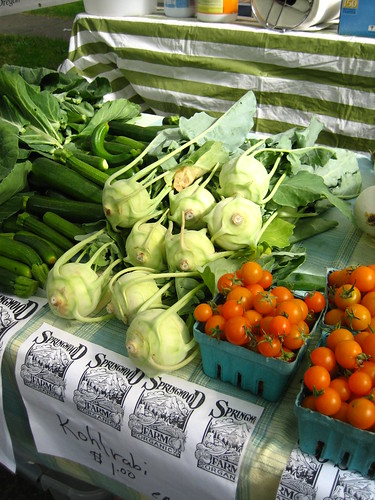 And…we’re BACK!! And we are circling around again, on the subject of farmers’ markets because – I say so. A reader of the last piece told me that she does not go to ‘her’ farmers market because they only had two vendors and all the vendors had were greens and green onions.
And…we’re BACK!! And we are circling around again, on the subject of farmers’ markets because – I say so. A reader of the last piece told me that she does not go to ‘her’ farmers market because they only had two vendors and all the vendors had were greens and green onions.
OK…we’ve got two issues here. First is probably the fact that north of some predetermined spot, it’s really too early to find a whole lot more than green onions and greens. It’s just not warm enough yet and the farmers, even with row covers, etc. will not have had enough time to actually grow a whole lot. And second, Aunt Toby realizes that some farmers’ markets are NOT very special – the one closest to you might not be – the one in the next town over might be. It’s worth doing some searching to find all the markets in your area and doing some comparison shopping. How to find farmers markets near you?
“Near you” is sort of a nebulous concept, I realize because in my area, depending on what part of the week we’re talking about, ‘near me’ might be downtown, and sponsored by the City Department of Economic Development. Or on another part of the week, it is in a county park. At another part of the week, it is out at the western end of our county, in the parking lot of one of the Town Libraries. It’s sort of fluid. So, it behooves you to check out web sites or call such people as:
— City government
— County Government
— Township offices
— County/City Dept. of Parks and Recreation
— Your county’s Cooperative Extension
— Your state’s Department of Agriculture (or Agriculture and Markets)
Once you get a listing with addresses and the schedule of dates and times, then you can take your shopping list and do some visits and see who has what. Every farmers’ market has its own ambiance — market managers will truly try to have a little bit of everything and will also try to recruit vendors who have something a little bit unusual to attract more consumers. Some are more ‘hard core’ in terms of fruits and veggies; others are more of what I’d call a destination, and will have everything and anything anyone can make, produce, bake, or grow on sale. It is up to consumers to find the places where what they are looking for is available to them and at a price they are comfortable paying.
On the other side, though, nearly every farmers’ market is going to have something special about it and that is going to be fruits and veggies that perhaps consumers are not familiar with. In a grocery store, it’s sort of easy to ignore weird veggies and fruits because the entire trip is sort of a chore anyway. Going to a farmers’ market is meant to be more charming and fun and educational. And there will be some vendors who want to make it as educational as they can and will offer recipes, free samples and so on. If you find a vendor like that, then make use of them. They are extending themselves to you and you should open your brain and your mouth and try things out.
 My best example is the humble but strange veggie illustrated here: Kohlrabi. Aunt Toby considers herself to be a pretty adventurous consumer but I had never had kohlrabi before I walked in front of a vendor at one of our local farmers’ markets and was offered a free sample – the vendor was basically just cutting up a washed, peeled green kohlrabi and offering people pieces to try. The DH and I were a little dubious, but we gave it a shot and found the veggie to be a very subtle version of cabbage, which should not have surprised us at all since ‘kohl’ in the name should have been a dead giveaway of its family. That’s the reason that one of America’s favorite salad dishes is called Cole Slaw. Kohl is the German word for cabbage; rabi is a German variant of their word for turnip, which if you look at the shape of the thing, makes perfect sense.
My best example is the humble but strange veggie illustrated here: Kohlrabi. Aunt Toby considers herself to be a pretty adventurous consumer but I had never had kohlrabi before I walked in front of a vendor at one of our local farmers’ markets and was offered a free sample – the vendor was basically just cutting up a washed, peeled green kohlrabi and offering people pieces to try. The DH and I were a little dubious, but we gave it a shot and found the veggie to be a very subtle version of cabbage, which should not have surprised us at all since ‘kohl’ in the name should have been a dead giveaway of its family. That’s the reason that one of America’s favorite salad dishes is called Cole Slaw. Kohl is the German word for cabbage; rabi is a German variant of their word for turnip, which if you look at the shape of the thing, makes perfect sense.
If you are already eating cabbage, broccoli or any of its cousins, why bother eating kohlrabi? Well, cabbage can, if the weather is hot and dry, taste pretty hot and peppery and broccoli sometimes is not available. Kohlrabi is grown fast and eaten at the baseball size. It’s very nutritious, has 103% of the daily nutritional requirement of Vit. C. , has a good bit of fiber going for it and you can use it in stir fries, soups, and even…grated up as a very nice, subtle ‘cole slaw’. Once it gets really big, it’s no longer good and is very woody, so don’t buy those. There are a bunch of cultivars out there, including a purple one (purple veggies are the hot item these days; there are even purple carrots out there).
Here’s a great collection from Simply Recipes: kohlrabi
Here is a great site that gives veggie history on kohlrabi (hey – this veggie goes back to Roman times). kohlrabi 2
But the message remains – if you see something displayed at a farmers market that you don’t recognize, you still know something about it. First, the farmer would not be growing it and selling it if it was not something that did not do well in your area (always a great advantage in terms of eating locally). And second, it’s something that is definitely worth trying. Walk right up, stick out your pointer finger and say to the vendor – ‘What’s that? Can I eat it raw? And can I have a sample?” Usually, the vendors will be more than happy to give you one – they just might make a sale.
This is not to say that you should only go to farmers’ markets to look for unusual veggies; frankly as far as I’m concerned, consumers should do as much local fresh shopping as they can. But something that makes farmers’ markets ‘special’ is that vendors are willing to try something different or unusual and it’s up to us as consumers to give it a shot to encourage them to do so.
(photos courtesy of emptyhighway and pomax)
